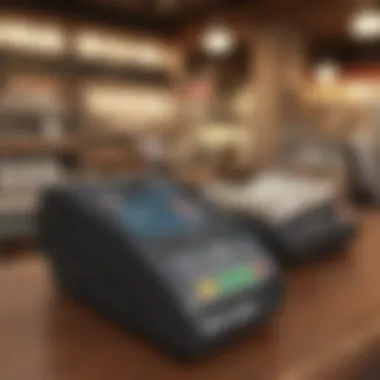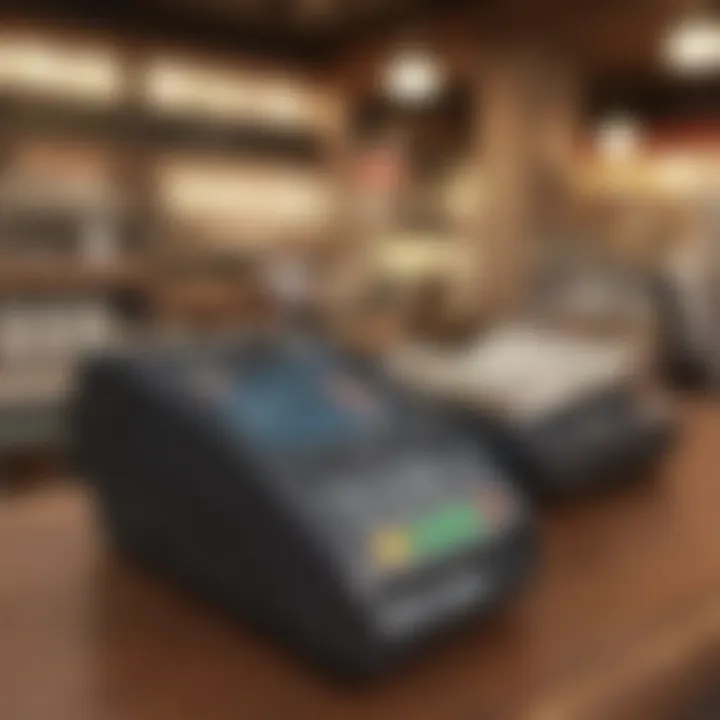Exploring Restaurant POS Systems: Types and Benefits


Intro
In the bustling world of restaurants, the Point of Sale (POS) system stands as a cornerstone of operations, influencing everything from order taking to payment processing. As technology advances, the range of systems available has expanded, leading to numerous options that cater to different needs within the industry. Understanding the various types of POS systems and their unique functionalities not only helps restaurant owners streamline their operations but also enriches the customer experience in meaningful ways.
With an ever-changing technological backdrop, comparing the merits and drawbacks of each system is crucial for stakeholders—from seasoned investors to new entrepreneurs. This article endeavors to illuminate the multifaceted terrain of POS systems, underscoring their relevance in today’s dining environments. By doing so, we aim to foster a deeper comprehension of how these systems significantly contribute to operational efficiency and business success.
Investment Dictionaries
Understanding Key Terms
When diving into the realm of POS systems, it's imperative to grasp certain terminology. This enables restaurant owners to make informed decisions. Key terms include:
- Cloud-Based POS: A system that operates via the internet, eliminating the need for local servers.
- Integrated Payment Solutions: Features that allow seamless handling of various payment methods under a single interface.
- Mobile POS: Handheld devices that facilitate transactions and enhance staff mobility.
- Inventory Management: Tracks stock levels, alerts when to reorder, and helps minimize waste.
Next, understanding these terms sets the stage for smarter investment choices in restaurant technology, which in turn impacts profitability.
Common Investment Strategies
Investing in a POS system isn't just about the purchase price. It involves a strategic approach that varies based on the restaurant's scale, service type, and long-term goals.
- Assess Operational Needs: Before committing, owners ought to evaluate how a system aligns with their specific workflows.
- Prioritize User Experience: A system should simplify tasks for staff and enhance interactions for customers.
- Plan for Scalability: Choose systems that can adapt as the business expands, be it through additional features or integration with other tools.
- Evaluate Total Cost of Ownership: Beyond the purchase price, consider ongoing fees, support, and potential upgrades.
Establishing a clear understanding of these elements paves the way for well-informed investment choices in restaurant POS systems. With this foundational knowledge, stakeholders can better appreciate how these systems fit into the larger puzzle of operational efficiency and guest satisfaction.
Intro to POS Systems in Restaurants
Point of Sale (POS) systems serve as the backbone of any restaurant's operational framework. Their presence is crucial, as these systems not only streamline transactions but also enhance overall management capabilities. For anyone involved in the restaurant business, understanding the various types of POS systems available can dramatically influence decision-making processes and operational success. This journey through POS systems dives deep into the specific elements that make each type distinct, illuminating both their benefits and potential drawbacks.
Definition and Purpose
A Point of Sale system typically refers to the hardware and software that enable restaurants to manage sales and transactions efficiently. In simple terms, it's where customers interact with the establishment to make payments. But POS systems go beyond mere transactions; they're integrated tools designed to handle various tasks such as inventory management, sales analytics, and customer relationship management.
The primary purpose of a POS system is to facilitate the purchasing process, allowing restaurant staff to take orders, process payments, and generate receipts. However, the advancing nature of technology means that modern POS systems now feature extensive capabilities like real-time reporting and mobile access. This multi-functionality effectively transforms a regular transaction point into a dynamic hub for data collection and operational management.
History of POS Technology
The evolution of POS technology has been nothing short of remarkable. The initial phases date back to the late 19th century when the first cash registers were introduced. These rudimentary tools were primarily mechanical, providing a way to ensure accurate cash handling. As businesses expanded, so did the need for improved efficiency.
The journey from these mechanical systems to electronic variants began in the 1970s. With the rise of personal computers, restaurants started adopting computer-based systems which allowed for more sophisticated operations. Fast forward to the 21st century, we see cloud-based solutions and mobile applications taking center stage. This shift not only makes the systems more accessible but also allows for incredible flexibility and integration with numerous other services.
As we move into a new era marked by artificial intelligence and data analytics, the role of POS systems continues to grow. They are no longer just about transactions; they're pivotal in shaping the customer experience and providing business insights.
"Understanding the capabilities of POS systems is crucial; it can determine the heart of your restaurant's operation, shaping everything from transactions to customer engagement."
In summary, grasping the fundamentals of POS systems, their definitions, purposes, and historical context provides invaluable insights. This knowledge forms the bedrock upon which stakeholders can assess which type of system best fits their business model.
Traditional POS Systems
Traditional POS systems play a crucial role in the ecosystem of restaurant operations. While many new technologies are making their mark, understanding these systems gives a better insight into how restaurants have long managed sales, inventory, and customer interactions. These systems are the backbone of many establishments and have unique characteristics that remain relevant even as the industry evolves.
Cash Register Systems
Cash register systems represent the oldest form of POS technology. They often consist of a basic cash drawer and a receipt printer, designed primarily for handling cash transactions. The beauty of cash registers lies in their simplicity. They are easy to use, making them accessible for staff who might not have extensive training in technology.
However, modern restaurants often seek more than just basic functionalities. While these systems can be reliable, they lack the flexibility and extensive reporting capabilities that many operations demand today. For example, cash registers don’t really keep track of inventory or provide sales analytics—it’s all about the money moving in and out. In a fast-paced restaurant setting, this can become a significant limitation, especially when trying to understand shifts, preferred menus, or peak hours.
Terminal-based Solutions
Terminal-based POS solutions add a layer of functionality over traditional cash registers. They typically involve software that runs on hardware terminals, allowing for a broader range of operations. It’s not just about cash transactions anymore; terminal systems manage orders, track inventory, and analyze sales data. These systems can process various payment methods, accommodating credit cards and digital wallets alongside cash.
Key Features
A standout feature of terminal-based solutions is their ability to integrate with other systems. This means restaurants can connect with their inventory management or customer relationship management solutions seamlessly. For instance, when an item is sold, the terminal can automatically update inventory records—this limits overstocking or stockouts.
They also often come with detailed reporting capabilities. Managers love features that allow them to analyze sales patterns over time. Such insights enable them to make informed decisions, like adjusting staff scheduling according to busy periods or promoting specific items that have strong sales cycles.
Limitations


Despite their advantages, terminal-based systems have limitations. A significant drawback is their reliance on hardware and the need for sometimes costly maintenance. For one, if the terminal faces technical issues, restaurant operations can grind to a halt. A broken point of sale can mean lost sales and frustrated customers waiting in line to be served.
Additionally, not all terminal-based solutions are user-friendly, especially for employees not tech-savvy. Some systems require extensive training, which can take time. If staff turnover is high, as it often is in restaurants, the learning curve can slow down operations in the busy hours.
Overall, while traditional POS systems—ranging from cash registers to terminal solutions—continue serving their purpose in the restaurant industry, understanding their limitations and capabilities is critical in the decision-making process for restaurant owners and investors alike. The nuances of these systems directly impact operational efficiency and customer satisfaction.
Cloud-based POS Systems
Cloud-based POS systems are becoming increasingly relevant in the restaurant industry, offering flexibility and innovation in a field that demands efficiency and adaptability. These systems allow restaurants to store data on remote servers, making access to sales information and operational tools significantly easier. With countless restaurants shifting away from traditional hardware setups, cloud-based systems facilitate not only daily transactions but also broader managerial insights. Let's delve into the advantages and notable solutions that characterize this modern approach.
Advantages of Cloud Technology
Access Anywhere
The Access Anywhere feature stands out in cloud-based POS systems. This that means users can manage their business from almost anywhere—be it the dining room or even while sipping coffee at a nearby café.
The key characteristic of Access Anywhere is that it breaks down geographical barriers, allowing managers to monitor sales in real time without being tied to a physical location. This is especially valuable for multi-location establishments, where keeping tabs on various outlets is often a daunting task.
A unique feature of this aspect is its compatibility with mobile devices. Restaurant owners can check their systems via smartphones or tablets, gaining a clear picture of inventory, sales, and employees at their fingertips. However, a consideration to keep in mind is the reliance on stable internet connectivity. If the connection drops, it can hinder access, causing a bit of anxiety during peak hours when decisions must be made swiftly.
Automatic Updates
Another notable advantage of cloud-based systems is Automatic Updates. This ensures that restaurants are always using the latest software versions without the hassle of manual installation. The importance of this cannot be overstated: it means that businesses benefit from enhanced features, security patches, and bug fixes as soon as they become available.
With Automatic Updates, restaurants can operate with less downtime. The updates happen on the cloud provider’s schedule, which typically causes minimal disruption to daily operations. This keeps systems running smoothly and securely, which is paramount in today’s digital landscape.
A unique feature worth mentioning here is the ability to trial new functionalities before committing. Some providers allow users to test features before they roll them out universally, providing a chance to adapt based on employee feedback. On the other hand, automatic updates can occasionally lead to unexpected changes that might confuse staff until they adjust to the new interface or functionalities, creating a temporary learning curve.
Popular Cloud POS Solutions
In the realm of cloud-based POS systems, several platforms have garnered attention for their distinct features and user-friendliness. Understanding these options can significantly aid restaurants in selecting the right solution.
Square
Square offers an intuitive interface, making it a favorite for many small to medium-scale restaurants. Its simple setup means that even tech novices can start accepting payments quickly, making it a beneficial choice for startup eateries.
The key characteristic of Square is its no-manual-fees structure, which means users only pay transaction fees without any hidden charges. This kind of transparency resonates well with entrepreneurs trying to manage budgets effectively. A standout feature is the analytics dashboard, which provides insights into sales patterns and customer behavior, helping owners make more informed decisions. However, one must be cautious about the limitations on advanced features, which might not meet the needs of larger establishments.
Toast
Toast shines in its specialization for the restaurant sector, integrating every aspect of a restaurant's operations into one comprehensive system. This is particularly helpful in streamlining tasks from ordering to payment.
The key characteristic of Toast is its robust online ordering capabilities, which have grown increasingly important. With more consumers preferring to dine at home, Toast helps restaurants optimize their delivery and takeout services seamlessly. It also boasts of detailed reporting tools. While this system excels in its functionalities, potential drawbacks include a steeper learning curve for staff who've never worked with such comprehensive systems.
Lightspeed
Lightspeed takes things a step further by being highly customizable, which is perfect for restaurants looking to tailor their POS systems to fit specific needs. This flexibility is one of its distinguishing features.
A notable characteristic of Lightspeed is its integration options with various third-party applications, such as inventory management and customer relationship management systems. This interoperability allows for a more holistic view of restaurant operations. On the downside, some users have reported that the interface can appear visually cluttered, which may be daunting for new users.
Mobile POS Systems
In an ever-evolving dining landscape, mobile POS systems stand out as a game changer for restaurants. These solutions not only streamline operations but also enhance the overall experience for both staff and customers. Integrating this technology allows restaurants to adapt to changing needs, catering to diners who expect speed and efficiency.
Functionality and Benefits
Portability
The hallmark of mobile POS systems is their portability. This feature enables staff to bring the POS right to the customers, rather than having them wait in line or flag someone down for service. Imagine a bustling restaurant where every server has the means to take orders tableside without a cumbersome system slowing them down. Portability here is more than just a fancy term; it's a necessity that reflects a restaurant's commitment to service.
One unique aspect of portability is its impact on service speed. Instead of sending orders to a centralized kitchen system, servers can punch in requests right away, cutting down on potential wait times and errors. However, while this benefit is evident, one must also consider the trade-offs. Relying on mobile devices raises concerns about battery life and connectivity, which, if compromised, could disrupt operations. Overall, the upsides of portability in mobile POS systems often outweigh these downsides for establishments eager to enhance efficiency and customer satisfaction.
Enhanced Customer Interaction
Mobile POS systems also elevate the quality of enhanced customer interaction. This technology helps create a more engaging experience by allowing staff to connect with diners in a more meaningful way. For instance, with a mobile device, servers can easily offer personalized recommendations based on customer orders or preferences, tapping into data that traditional systems might not facilitate as fluidly. This personal touch can foster loyalty and make guests feel valued.
The real game-changer here is how these systems facilitate real-time feedback. Staff can ask how a dish was prepared and quickly relay customer comments back to the kitchen, acting like an invaluable communication link. Nevertheless, there are challenges—the balance between tech and personal touch must be maintained. Over-reliance on devices could inadvertently make interactions feel scripted rather than spontaneous. Still, the benefits of enhanced customer interaction via mobile POS systems are significant and can lead to memorable dining experiences.
Integrating Mobile Devices


Integrating mobile devices with restaurant operations requires careful planning and execution. The alignment of different technologies, from the POS system itself to inventory and staff management tools, plays a crucial role in ensuring a seamless experience. Restaurant owners need to evaluate how well their existing systems can work with mobile technology. For some, this integration might mean investing in robust software solutions that synchronize effectively.
However, the integration process comes with its own set of challenges. Training staff to use mobile devices efficiently can consume time and resources. Furthermore, each new technology introduced into a restaurant's ecosystem can bring unexpected hurdles, like compatibility issues or user resistance. Therefore, thoughtful consideration and practical testing can pave the way for a smoother transition.
Adopting mobile POS systems encompasses understanding their functionalities and potential pitfalls. As restaurants navigate this terrain, the adaptability that these systems can offer is certainly worth the effort.
Self-Service Kiosks
In today’s fast-paced restaurant environment, self-service kiosks have made a significant impact. These systems allow customers to place their orders directly, bypassing the traditional wait times of interacting with staff. This integration of technology not only streamlines operations but also caters to the increasing demand for faster service.
Operational Efficiency
Self-service kiosks contribute to operational efficiency in multiple ways. Firstly, they can operate around the clock, providing service even during peak hours. This automation reduces the burden on staff, allowing them to focus on other critical areas, such as food preparation and customer assistance. With the need for fewer staff members on the floor, restaurants can minimize labor costs while maintaining service quality.
Moreover, kiosks make the ordering process clearer. Customers navigate straightforward interfaces to select their meals, and this can significantly reduce order errors. Less confusion often results in fewer misunderstandings that can lead to food remakes or refunds, thus saving time and resources. Here's a breakdown of their efficiency benefits:
- Increased Order Accuracy: Customers input their orders directly, eliminating human errors.
- Quick Service Times: Kiosks speed up the order process, allowing guests to receive their meals faster.
- Better Management of Peak Hours: During busy periods, kiosks help alleviate the pressure on staff, ensuring smooth service.
Using self-service kiosks can help restaurants stay ahead of the game in an industry that thrives on speed and convenience.
Customer Experience Enhancement
Enhancing the customer experience is another vital aspect of self-service kiosks. Customers today often prefer more control over their ordering process. Kiosks allow them to explore the menu at their own pace, customize their orders easily, and even see nutritional information, which can lead to better dining choices. This level of autonomy can lead to a more satisfying experience.
Kiosks can also incorporate engaging visuals and interactive elements that grab attention. Many systems have been designed with appealing interfaces that mimic gaming styles, making the ordering process enjoyable.
Additionally, the anonymity of ordering through a kiosk can reduce the social pressure some customers feel when being served by a staff member. Customers can take their time in making decisions without worrying about the weight of expectation to hurry up.
In summary, kiosks not only enhance operational efficiency but also significantly elevate the dining experience. By leveraging technology, restaurants can meet modern consumer expectations, maximizing satisfaction and loyalty.
"The integration of self-service kiosks is not just a trend; it's pivotal for operators seeking efficiency and customer satisfaction in the competitive restaurant landscape."
In an age where technology infiltrates every aspect of our lives, self-service kiosks stand as a testament to how the restaurant industry is adapting, ultimately paving the way toward a more innovative future.
Integrated Payment Solutions
In the world of modern restaurant operations, integrated payment solutions can change the game. They take away the hassle of juggling multiple payment methods and streamline the entire transaction experience. This not only improves the speed of service, but also enhances the customer experience, as diners appreciate the efficiency.
When considering integrated payment solutions, it’s crucial to think about how they fit into the overall restaurant ecosystem. These systems allow the merging of payment processing with POS systems, ensuring that all aspects of a transaction—like orders, payments, and tips—are documented seamlessly. This connection can significantly reduce errors, as details don’t need to be manually entered in different platforms.
Importance of Payment Integration
Payment integration within the restaurant sector goes beyond merely allowing credit card transactions. The importance lies in its ability to unify various payment forms, ranging from credit and debit cards to mobile wallet solutions like Google Pay or Apple Pay. Here are some key reasons to consider payment integration:
- Improved Efficiency: By having a unified platform, servers can process payments at the table, which expedites turn times and keeps guests happy.
- Reduced Errors: An integrated system minimizes the risk of transposed numbers and mismatched details between order and payment records.
- Comprehensive Reporting: Integrated payment systems offer sophisticated analytics, enabling restaurants to analyze sales trends, peak hours, and other important metrics that inform business strategy.
- Customer Preferences: Today’s diners expect flexibility in payment options. By integrating multiple payment methods, restaurants can meet diverse customer preferences, ultimately leading to increased satisfaction.
Popular Integrated Payment Providers
When it comes to integrated payment solutions, two of the most recognized names in the industry are PayPal and Stripe. Each provider offers unique functionalities that can suit various business models.
PayPal
PayPal continues to stand out as a preferred choice for many restaurants due to its robust ecosystem and trust factor among consumers. One key characteristic of PayPal is its well-established brand reputation. This reputation provides customers with confidence during transactions.
A unique feature of PayPal is its capability for easy integration with existing e-commerce setups and POS systems. This means it can efficiently handle both online orders and in-person payments, a flexibility that is essential for today’s hybrid dining experiences.
However, while PayPal is widely accepted, its fees can be a consideration. Some find their rates on the higher side compared to other processors, which might not make it the best option for every establishment.
Stripe
Stripe has carved out a niche in the payments landscape, being particularly favored by tech-savvy restaurants looking for customization. Its key characteristic is its developer-friendly API, which allows businesses to tailor the payment process to their specific needs.
A distinguishing feature of Stripe is its advanced fraud prevention tools, which offer an additional layer of protection for both restaurants and their customers. The system also provides detailed reporting and analytics, giving owners insight into payment performance and customer behavior.
On the downside, the complexity of Stripe's integration may pose challenges for those without a tech background. It requires some developer resources to fully utilize its potential, which can deter smaller establishments lacking this expertise.
"Choosing the right payment provider can greatly influence your bottom line; a thoughtful decision may lead to both enhanced efficiency and customer satisfaction."
In summary, the integration of payment solutions into restaurant systems is not just a matter of convenience but rather a strategic move towards operational effectiveness and customer-centric service.


Choosing the Right POS System
When diving into the world of restaurant management, picking the right Point of Sale (POS) system can feel a bit like finding a needle in a haystack. With so many options floating around, it's crucial to sift through the noise and narrow down what really fits your business. A well-chosen POS system can streamline operations, enhance customer satisfaction, and ultimately boost profits. So, how do you decide?
Assessing Business Needs
Before making a leap, it’s imperative to take a good look in the mirror and assess your restaurant's needs. Knowing what you're working with is half the battle.
Volume of Transactions
When it comes to Volume of Transactions, understanding your sales flow is essential. High-volume establishments, like bustling bistros or fast-paced cafes, necessitate POS systems that can handle a hefty amount of transactions simultaneously. The key characteristic of this aspect is its demand for speed and efficiency. High transaction volumes mean that any processing delays can lead to long lines and frustrated customers.
For instance, using a system that allows for quick order inputs and faster payment processing can be a game-changer here. On the flip side, smaller establishments might not need the same robust capabilities but should consider scalability if they plan to grow in the future. Finding a system that doesn’t skimp on performance, regardless of size, makes Volume of Transactions a pivotal factor in the purchasing decision.
Type of Establishment
Next up, we have the Type of Establishment you’re running. A fine dining restaurant, for example, will have different needs compared to a food truck or a coffee shop. The unique characteristics of a fine dining service demand detailed order customization, so a system that supports tables and courses in-depth is beneficial. High-ticket items typically mean more complex transactions, and having a tailored solution can facilitate better service.
In contrast, a quick-service restaurant might prioritize speed and simplicity over an extensive feature set. Choosing a POS that aligns with your type of establishment can also help to enhance the user experience for both your staff and customers. For example, lighter interfaces work wonderfully in high-turnover environments, where every second counts. Knowing whether your restaurant leans toward fine dining or a more casual vibe directly informs your POS choice.
Comparing Features and Costs
Now that you’ve assessed those business needs, the next step involves comparing features and costs. Since we're not made of money, this part requires careful consideration. You’ll want to draft a list of essential features—think inventory management, reporting capabilities, and customer relationship management. Once you know what’s critical for your operations, start matching these features against budget constraints.
- Cost: Some POS systems charge monthly fees, while others are outright purchases. Understanding the long-term costs, including software updates and hardware replacements, will prevent you from getting caught off guard.
- Features: Make sure you’re not paying for features you might not use. If you’re a small mom-and-pop shop without a robust delivery service, there’s no need to invest in heavy-duty logistics capabilities.
A well-thought-out POS system can significantly improve not just your workflow but also the dining experience for your customers, making it a worthwhile investment.
By looking critically at business needs and weighing the importance of transaction volume and establishment type, while also comparing features with costs, you set yourself on a fruitful path towards a smart POS investment.
Future Trends in POS Technology
The realm of Point of Sale (POS) systems is undergoing a noteworthy transformation, shaped by evolving consumer expectations and technological advancements. This section aims to shed light on the burgeoning trends influencing POS technology within the restaurant sector. With these changes, restaurants can enhance their efficiency, improve customer interactions, and ultimately drive profitability.
Diving into these trends, we examine two critical areas: Artificial Intelligence Integration and Improving Data Analytics Capabilities. These aspects are not just buzzwords; they are pivotal in how establishments will operate in the near future.
Artificial Intelligence Integration
AI technologies are increasingly being incorporated into POS systems to streamline operations and enrich customer experience. By leveraging AI, restaurants can analyze vast amounts of data quickly and deliver personalized service. For instance, a system can track customer preferences over time. If a diner frequently orders a specific dish, the POS can offer that choice upon their next visit.
Furthermore, AI can automate inventory management. With smart monitoring, restaurants can prevent shortages and reduce food waste by informing staff about low-stock items in real-time. This capability helps maintain optimal operational flow and minimizes potential disruptions.
An important consideration related to AI integration is the initial investment and the staff training required for effective implementation. However, the long-term benefits often overshadow these costs.
"In the coming years, AI will not just be an advantage but a necessity for competitive survival in the restaurant industry."
Improving Data Analytics Capabilities
As technology progresses, the ability to collect and interpret data is becoming increasingly sophisticated. This improved data analysis plays a crucial role in decision-making processes. POS systems equipped with enhanced analytics offer managers insights into sales trends, customer behavior, and operational efficiencies.
By utilizing real-time analytics, restaurant owners can respond swiftly to changing market dynamics. For example, if data reveals a spike in brunch orders during weekends, a restaurant could adjust staffing or menu choices accordingly, maximizing both efficiency and customer satisfaction.
Additionally, advanced analytics can identify marketing strategies that work. By tracking customer purchasing patterns, restaurateurs can tailor promotions to specific demographics, which can lead to increased turnover and customer loyalty.
In summary, as we look at these future trends in POS technology, it becomes clear that embracing AI and advanced analytics is becoming vital. These innovations not only bring operational efficiencies but also provide the tools necessary to enhance the overall dining experience. For modern restaurants, the path forward will hinge largely on how effectively they can integrate these trends into their daily operations, thereby positioning themselves for success in a competitive marketplace.
The End
In the bustling realm of the restaurant industry, embracing the right Point of Sale (POS) system can set the stage for operational success. This article has traversed a broad spectrum of POS systems, each with its unique strengths and challenges. The importance of recognizing the right fit cannot be overstated, given the pronounced impact on efficiency, data management, and customer interactions. A fitting POS system not only streamlines transactions but also enhances the overall dining experience.
The various types of systems—from traditional cash registers to modern mobile solutions—offer an array of functionalities that directly affect how establishments operate. Factors like ease of use, integration capabilities, and price points are pivotal in decision-making. The optimal choice can lead to reduced wait times, improved order accuracy, and ultimately, higher customer satisfaction. In that light, understanding these nuances is essential for making informed decisions regarding POS investments.
Moreover, the future of POS technology is one rife with potential. Trends such as artificial intelligence and advanced analytics promise to transform how restaurants engage with their customers. Keeping an eye on these trends helps stakeholders not just stay relevant, but also gain a competitive edge.
Summary of Key Points
- Diverse Types: Different POS systems cater to various needs—traditional, cloud-based, mobile, and self-service kiosks.
- Operational Efficiency: The choice of POS affects transaction speed, accuracy, and overall workflow.
- Customer Experience: An effective POS system enhances the interaction between staff and customers, leading to improved satisfaction.
- Integration and Scalability: Opting for systems that integrate seamlessly with existing technologies can maximize benefits and adaptability.
- Future Trends: Keeping an eye on emerging technologies such as AI can provide innovative opportunities for restaurants.
Final Thoughts on POS Investment
Investing in a POS system isn't just an operational concern; it's a strategic decision that influences the restaurant's financial health. With technological advancements spiraling at an unprecedented rate, restaurant owners must navigate their choices with discernment. As they weigh the pros and cons of different systems, it’s crucial to align their selections with their business goals and customer expectations.
Evaluating needs—be it the volume of transactions, type of cuisine, or targeted customer base—plays a significant role. A tailored solution can effectively manage the flow from order taking to payment processing, ensuring that diners leave with a smile. Furthermore, the scalability of the chosen system should not be overlooked; as businesses grow, so too must their POS capabilities.
Ultimately, acknowledging the significant role of a POS system can empower restaurant stakeholders to enhance their operations while enriching customer experiences. In a competitive marketplace, those who adapt and thrive will undoubtedly lead the charge into an exciting future.



